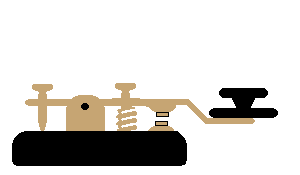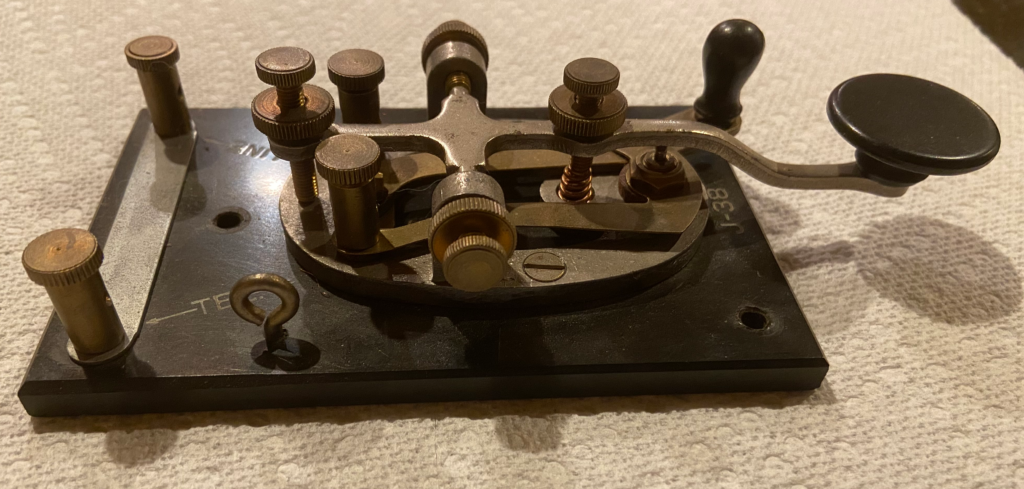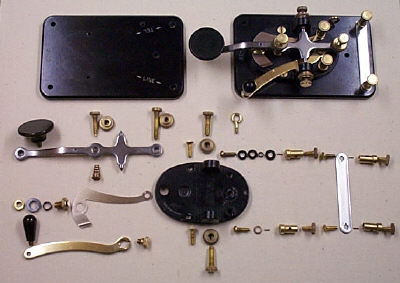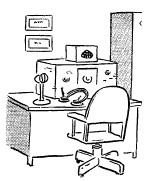
From K6IX’s website:
Here is the method I use to clean my J-38 keys. Some key collectors believe that keys should be left exactly as they are found, but considering the construction, materials, and ubiquity of J-38 keys, I think that carefully and gently cleaning them is appropriate. Do not, under any conditions use wire brushes or other highly abrasive methods.
1. Disassemble the key. Look carefully for, and set aside, the positioning pins in the binding posts (if they are loose) and all of the fiber washers. Put the bakelite and hard rubber parts in soapy water. Put the metal parts in ammonia. Let both soak overnight. Don’t panic, because some of the metal parts will turn black.
2. Carefully wash off the bakelite/rubber parts. If the two knobs are very dull I sometimes us black shoe polish on them. The bakelite you can carefully clean with Flitz (see below) if it is still dirty or discolored.
3. The metal parts I clean first with “Nevr-dull”. It is a “wadding polish” product that I get here in a hardware store, but I think it is also sold in boat stores, grocery stores, auto stores, etc. It is manufactured by The George Basch Co., Inc., Freeport, New York, 11520, USA.
4. Then I clean some of the larger metal parts with “Flitz”, which is a metal/fiberglass cleaner made in West Germany and packaged in the USA by Flitz International, Ltd., WI 53185. It is available in boat stores, and I buy it from West Marine on the internet (www.westmarine.com). Just get a very small tube of it–it goes a long way. Flitz protects the metal from corrosion.
The most important step is #1. The soaking makes a big difference!
I have started the process of cleaning an ol’ J-38. Here is the before picture:

There is also some guidance (based on K6IX’s recommendations) from N2HTT’s website. Here is what he had to say:
Soak all the parts in household ammonia solution overnight. I collected the parts in groups, so I could figure out how they went back together. Also, I separated the white metal parts from the brass ones, not wanting any weird galvanic thing happening to them while soaking. I had visions of all the brass bits disappearing overnight or something like that. I have a bunch of these all-plastic ice cream jars (the family consumes a bunch of this stuff, good ice cream, great jars) that were ideal for the task. As Scott predicted, the white metal parts turned black overnight, but this is expected and not harmful.
Initial polish with Brasso. This removed the residue from the soaking.
Polish the parts again with Flitz Blue. You can find it on Amazon. This stuff is amazing. You can even use it on the painted parts, diluted.
+-+-+-+-+-+-+-+-+-+-+-+-+-+-+-+-+-+-+-+-+-+-+-+-+-+-+-+-+-
This is my second effort at cleaning a J-38. The last one turned out pretty well and I gave it to a friend, encouraging them to give Morse code a try. This J-38 will be a loner to local hams aspiring to practice their straight key skills.
The parts have been soaking in an ammonia solution. This morning I realized I did not keep good track of where the rubber and cork washers went. Then I remembered I took step-by-step pictures of the last time I tore down a J-38… which I still have. These pictures clearly show where each part goes. Once I get all the parts clean on this key, I will reassemble, then take very good pictures with another disassembly to hopefully help anyone else looking for how to disassemble and reassemble a J-38.
K6IX has a picture of a disassembled J-38, but the image is a bit small.


 Keeping the shack in some semblance of order has always been a challenge for me. But the battle continues. Maybe a year ago or more I went through my shelves and transferred the vast majority of the contents that had been stored in a collection of totes and cardboard boxes to a fairly standardized set of see-through storage totes. During the holidays I went through these totes again to actually sort through the items to (1) see what I actually have and (2) attempt to organize and group items in some sort of systematized fashion. And now I am just about there.
Keeping the shack in some semblance of order has always been a challenge for me. But the battle continues. Maybe a year ago or more I went through my shelves and transferred the vast majority of the contents that had been stored in a collection of totes and cardboard boxes to a fairly standardized set of see-through storage totes. During the holidays I went through these totes again to actually sort through the items to (1) see what I actually have and (2) attempt to organize and group items in some sort of systematized fashion. And now I am just about there.